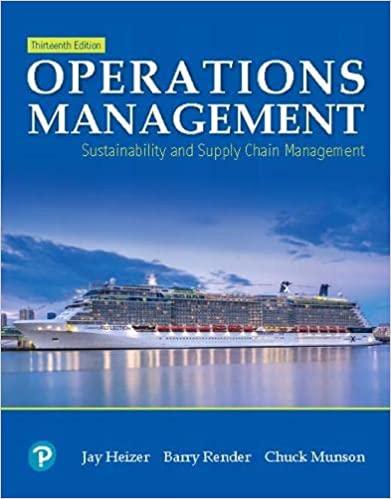Question
Topic: PERFORMANCE STRATEGIES Why is it important to measure organizational performance through HR metrics? How might individual performance strategies be aligned with HR and organizational
Topic: PERFORMANCE STRATEGIES
Why is it important to measure organizational performance through HR metrics? How might individual performance strategies be aligned with HR and organizational strategies?
An HR operating plan consists of various strategies that are aligned with the organization's mission, vision, and its larger strategies. Departments often develop performance goals as action steps that support organizational HR strategies identified to improve overall organizational performance. For this Presentation, you explore how various pay-for-performance strategies might support several organizational objectives and the HR operating strategies related to organizational performance.
Required Resources:
- Aryankhesal, A., Sheldon, T. A., & Mannion, R. (2012). Role of pay-for-performance in a hospital performance measurement system: A multiple case study in Iran Download Role of pay-for-performance in a hospital performance measurement system: A multiple case study in Iran. Health Policy and Planning, 28(2), 206-214. https://doi.org/10.1093/heapol/czs055
- Carlson, K. D., & Kavanagh, M. J. (2012). HR metrics and workforce analytics. In M. J. Kavanagh, M. Thite, & R. D. Johnson (Eds.),Human resource information systems: Basics, applications, and future directions(pp. 150-174). http://www.uk.sagepub.com/upm-data/41672_6.pdf
- Chavan, M. (2009). The balanced scorecard: A new challenge. Journal of Management Development,28(5), 393-406.
- Corsello, J. (2012). Maximizing talent management through the cloud.Human Resource Management International Digest,20(4), 27-30.
- Fink, A. A. (2010). New trends in human capital research and analytics.People and Strategy, 33(2), 14-21.
- Gates, S., & Langevin, P. (2010). Human capital measures, strategy, and performance: HR managers' perceptions.Accounting, Auditing & Accountability Journal,23(1), 111-132.
- Irs, R. (2012). Pay-for-performance in Estonian general educational schools: the situation for further development.Baltic Journal of Management, 7(3), 302-332.
- Lee, Y., & Lau, S. (2011). HR metrics, benefits brokers, workers in the European Union. HRMagazine, 56(9), 26-27.
- Longo, M., & Mura, M. (2008). Stakeholder management and human resources: development and implementation of a performance measurement system. Corporate Governance, 8(2), 191-213. https://doi.org/10.1108/14720700810863814
- Moyle, J. (2012). HR metrics: Measuring up: Strategic pay's latest HR metrics survey benchmarks everything from recruitment and training, to sick days, absenteeism and staff turnover. New Zealand Management, 42.
- Nyberg, A. J., & Ployhart, R. E. (2013). Context-emergent turnover (CET) theory: A theory of collective turnover.Links to an external site.Academy of Management Review, 38(1), 109-131. https://doi.org/10.5465/amr.2011.0201
- Patel, S. (2010). Empowering human capital management through HR metrics. Electric Light and Power, 88(1), 24, 26-27.
- Royal, C., & O'Donnell, L. (2008). Emerging human capital analytics for investment processes. Journal of Intellectual Capital, 9(3), 36-379. https://doi.org/10.1108/14691930810891983
- Schiemann, W. A. (2007). HR metrics: Myths, best practices, and practical tips.http://www.metrus.com/materials/HR_METRICS_Myths_and_Best_Practices.pdf
- Taticchi, P., Balachandran, K., & Tonelli, F. (2012). Performance measurement and management systems: state of the art, guidelines for design and challenges. Measuring Business Excellence, 16(2), 41-54. https://doi.org/10.1108/13683041211230311
- Weeks, K. O. (2013, June). An analysis of human resource information systems impact on employees. Journal of Management Policy and Practice, 14(3), 35-49.
- Weibel, A., Rost, K., & Osterloh, M. (2009). Pay for performance in the public sectorBenefits and (hidden) costs. Journal of Public Research and Theory. https://doi.org/10.1093/jopart/mup009
- Weyhrauch, W. S., & Culbertson, S. S. (2009). Creating a performance incentive system: Can risk, distortion, and manipulation be successfully balanced? Academy of Management Perspectives, 23(3), 98-100. https://doi.org/10.5465/AMP.2009.4347927
This week's assigned Presenter should post a PowerPoint presentation with a detailed notes section that contains the following:
- Incorporation and analysis of the Required Resources from this 2-week unit, including identification of any apparent gaps in the literature
- An original research topic related to the week's literature (the proposed research topic can be related to the general topic for the week or to gaps in the literature for the week, or it can be related to a specific reading for the week)
- Background information on the research topic, including identification of principal schools of thought, tendencies in the academic literature, or commonalities that define the academic scholarship regarding your topic
- Evaluation of the main concepts with a focus on their application to business/management practice and their impact on positive social change
- A minimum of 10 peer-reviewed, scholarly new references
The presentation must be in APA format and must incorporate direct evidence of addressing the Learning Objectives from this 2-week unit. Each of the content slides must include detailed notes/paragraphs with appropriate citation of peer-reviewed, scholarly references.
Step by Step Solution
There are 3 Steps involved in it
Step: 1

Get Instant Access to Expert-Tailored Solutions
See step-by-step solutions with expert insights and AI powered tools for academic success
Step: 2

Step: 3

Ace Your Homework with AI
Get the answers you need in no time with our AI-driven, step-by-step assistance
Get Started


